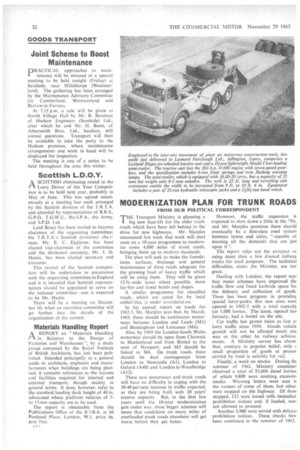MODERNIZATION PLAN FOR TRUNK ROADS
Page 34

If you've noticed an error in this article please click here to report it so we can fix it.
FROM OUR POLITICAL CORRESPONDENT
THE Transport Ministry is planning a big new face-lift for the older trunk roads which have been left behind in the drive for new highways. Mr. Marples announced last week that work will start soon on a 10-year programme to modernize some 4,000 miles of trunk roads. bringing them up to modern standards.
The plan will seek to iflake the foundations, surfaces, drainage and general maintenance of these roads adequate for the growing load of heavy traffic which will be using them. They will be given 124t.-wide lanes where possible, more lay-bys and fewer bends and slopes.
A similar programme for classified roads. which are cared for by local author:ties, is under ccnsiderat:on.
In his annual report on roads for 1962-3, Mr. Marples says that, by March, 1969, there should be continuous motorways between London and Leeds (M1) and Birmingham and Lancaster (M6).
Also, by 1969 the London-South Wales motorway should be open from Chiswick to Maidenhead and from Bristol to the west of Newport; and M5 should be linked to Mb. On trunk roads, there should be dual carriageways from London to Newcastle (Al), London to Oxford (A40) and London to Woodbridge (Al2).
These new motorways and trunk roads will have no difficulty in coping with the 30-40 per cent increase in traffic expected, as they are being built with 20 years' reserve capacity. But, in the first few years until the 10-year modernization gets under way. these bigger schemes will mean that conditions on many miles of overloaded trunk roads elsewhere will get worse before they get better.
However, the traffic expansion is expected to slow down a little in the '70s, and Mr. Marples promises there should eventually be a first-class road system between towns and cities, "capable of meeting all the demands that are put upon it ".
The report rules out the prospect of using more than a few disused railway tracks for road purposes. The technical difficulties, states the Minister, are too great.
Dealing with London, the report says that meter schemes have improved the traffic flow and freed kerbside space fat the delivery and collection of goods. There has been progress in providing special lorry-parks; five new ones were opened in 1962-3 with a total canacity for 1,000 lorries. The latest, opened last January, had a hostel on the site.
Car traffic has grown twice as fast at lorry traffic since 1954. Goods vehicle growth will not be affected much one way or the other by railway achieve. ments. A Ministry survey has showr that, contrary to popular belief, only small proportion of goods at preseni carried by road is suitable for rail.
Finally, a word on smoke. During tin summer of 1962, Ministry examinert observed a total of 83,000 diesel lorries of which 9,800 were emitting excessivt smoke. Warning letters were sent t2 the owners of some of them, but other: were stopped on the highway. Of thosi stopped, 132 were issued with immediati prohibition notices and, if loaded, wen not allowed to proceed.
Another 3,900 were served with delayei prohibition notices. These checks hayi been continued in the summer of 1963.








































































































